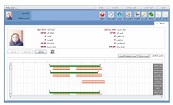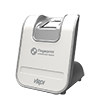Both industry and academics defined keystroke recognition as the process of measuring and evaluating a typing rhythm on digital devices, including laptop keyboards, mobile phones, and touch display screen panels.
Keystroke recognition often called “keystroke dynamics” refers to the detailed timing information that describes exactly when each key was pressed on a digital device and when it was released as a person types. Though biometrics tend to rely on physical traits like fingerprint and face or behavioral characteristics, many consider keystroke dynamics a biometric.
Biometrics Research Group, Inc. describes biometrics as observable physical and Behavioral Biometrics properties that make it probable to certify a private person’s identity.
The raw measurements used for keystroke dynamics are known as “dwell time” and “flight time.” Dwell time is the duration that a key is pressed, while flight time is the duration between keystrokes.
Therefore, keystroke dynamics can be defined as a software-based algorithm that includes both dwell and flight time to validate identity.
In 2004, researchers at MIT looked at the purpose of authentication through keystroke biometrics and identified a few significant advantages and disadvantages to the use of this biometric for authentication.
Advantages of keystroke dynamics:
- Prevent online frauds
- Reduce account sharing
- Validate Transactions
- As each keystroke is obtained entirely by key pressed and press time, data can be transmitted across low bandwidth joints.
- Measuring keystroke dynamics is an accessible biometric because it needs very little hardware besides a keyboard, making it easily deployable for use in businesses and other access security points, at a relatively low price.
That being said, MIT researchers also listed disadvantages to the use of keystroke dynamics as an authentication mechanism. Firstly, typing models can be irregular and incompatible as something like cramped muscles, and sweaty hands can change a person’s typing model significantly. Furthermore, MIT found that typing patterns vary based on the type of keyboard being used, which could dramatically complicate verification.
Despite these concerns, other studies note the general preference for biometrics in multi-factor authentication coupled with high awareness levels will benefit the continued growth in the keystroke dynamics market. At the same time, its attributes and low prices are expected to drive the use of technology in a wide variety of end-use applications.
Related posts







































































